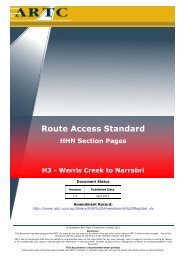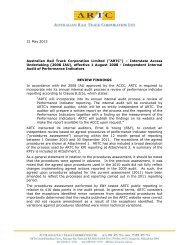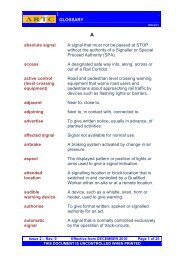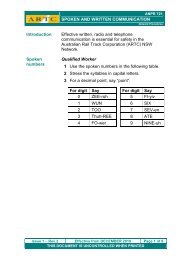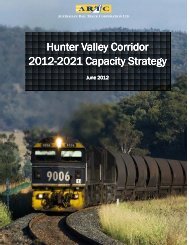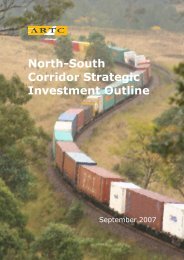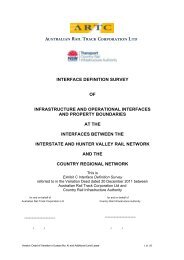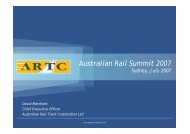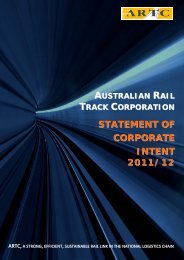MelbourneâBrisbane Inland Rail Alignment Study - Australian Rail ...
MelbourneâBrisbane Inland Rail Alignment Study - Australian Rail ...
MelbourneâBrisbane Inland Rail Alignment Study - Australian Rail ...
You also want an ePaper? Increase the reach of your titles
YUMPU automatically turns print PDFs into web optimized ePapers that Google loves.
4.5 Single track<br />
A further important assumption about the inland railway is that it will be single track for most of its length.<br />
For the coastal railway from Junee to Melbourne, ARTC plans to duplicate this track around 2013. 22<br />
The box below provides information about single track railways.<br />
BOX 6 Single track railway<br />
Many railways in Australia and around the world are single track, where trains run in both<br />
directions on the one line. The extra cost of double track (providing separate tracks for<br />
each direction of travel) is only justified for busy lines with high volumes, particularly<br />
those used for commuter services in cities or on busy freight lines like the Hunter Valley.<br />
On a single track railway, trains running in opposite directions can pass one another only<br />
where sections of track are provided for this purpose, termed passing loops or crossing<br />
loops. (In railway terminology, trains passing one another are said to ‘cross’.) The same<br />
applies to overtaking moves: for example a passenger train can only overtake a slower<br />
freight train at a loop, where the freight train waits for the faster train to go past. The term<br />
‘passing lanes’ is sometimes used for longer loops, for example those which have been<br />
built on the remaining sections of single line between Melbourne and Sydney.<br />
Train A<br />
Train B<br />
The process of crossing trains on a single track railway will always result in delays to at<br />
least one of the trains involved, as the train that enters the crossing loop must stop to wait<br />
for the opposing train to pass. The length of this ‘crossing delay’ will depend on the relative<br />
timing of the two trains’ arrival at the crossing loop. The challenge is to reduce crossing<br />
delays to a minimum, through the provision and optimum placement of adequate loops, and<br />
though timetabling and control of train operations, and through trains being driven within<br />
times allowed on each section. Modern signalling and control systems, such as ATMS<br />
(planned to be introduced by ARTC and assumed for the inland railway), assist in managing<br />
crossing movements. Nevertheless some level of delay due to crossings is inevitable, and<br />
must be allowed for in the timetable. In principle, delay on single track lines is minimised by<br />
a combination of adequate capacity, modern signalling and operational control, appropriate<br />
driving and use of reliable rollingstock. Thus all stakeholders are involved.<br />
As traffic grows on a single track railway, the number of crosses experienced by each train<br />
increases and hence the total crossing delays increase – leading to a longer end-to-end<br />
journey time for each train. The most cost-effective way to reduce these delays is to build<br />
more crossing loops. If this is done, a train will not have to wait so long for an opposing<br />
train to arrive and go past, allowing it to resume its journey sooner, thus reducing the delay<br />
associated with each individual cross. Adding loops is usually a much more cost-effective<br />
way of reducing overall transit time than shortening the line by building new track,<br />
termed a deviation.<br />
On the inland railway it has been assumed that sufficient crossing loops will be<br />
provided in the initial construction to cater for the level of traffic expected at that time<br />
and for some future traffic growth.<br />
4.6 Track categories<br />
The design, construction and maintenance of railways in Australia are documented in standards that generally cover<br />
individual states or apply network-wide. Different principles are adopted in the various locations, although a national<br />
code of practice is expected to be in place by the time the inland railway is in operation.<br />
For the purposes of this report, the use of track categories (Class 1 and Class 2) has been adopted for the<br />
specification of standards for the construction and maintenance of the proposed and existing alignments.<br />
22<br />
ARTC 2008, 2008-2024 Interstate and Hunter Valley <strong>Rail</strong> Infrastructure Strategy, 30 June 2008, p33<br />
4. Performance specification and design standards<br />
ARTC • Melbourne–Brisbane <strong>Inland</strong> <strong>Rail</strong> <strong>Alignment</strong> <strong>Study</strong> – Final Report<br />
29



